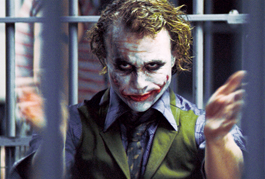home | metro silicon valley index | movies | current reviews | film review

Courtesy WB Pictures TM & ©DC Comics
WRAPPED TOO TIGHT: Could Heath Ledger's Joker really hail from the Big Uneasy?
The Man Who Laughs
As 'The Dark Knight' approaches, some clues on the origins of the Joker
By Richard von Busack
EVE-EN-ING, com-miss-ion-er." A.k.a. Jack Napier, a.k.a. the Red Hood, a.k.a. I. Rekoj, this character was (in 1952) diagnosed with hebephrenic schizophrenia and later credited with a death toll that ranges from 500 to 2,000. In 1940 alone, according to Batman historian Michael L. Fleisher, he killed a dozen victims, "most of them with a grisly venom, which, as it snuffed the life out of each gasping victim, contracted the muscles of the doomed man's face into 'a repellent, ghastly grin, the sign of death from the Joker.'"
We know where that goodbye look comes from: Conrad Veidt's Gwynplaine in the 1928 silent-film classic The Man Who Laughs, directed by Paul Leni. It is the grimace of a man forced to smile by the blade of a scalpel. Veidt's image was retrieved by Batman co-writers Bill Finger and Bob Kane, with the aid of illustrator Jerry Robinson.
Revived last week at the San Francisco Silent Film Festival, The Man Who Laughs hinges on its scene of revelation: a close-up of Gwynplaine's wide frozen grin making the idiot London rabble laugh. As Lon Chaney Sr. put it, "A clown is funny in the circus ring, but what would be the normal reaction to opening a door at midnight ... and finding that same clown standing there in the moonlight?"
A voice from such a face would be sibilant and juicy; that's how Mark Hamill voiced the Joker for many years in various animated shows and films. The voice as taken on by the late Heath Ledger in The Dark Knight, opening this week (see review on page 59), is something harder to pinpoint.
Alfred Jarry comes to mind first; he was a lunatic clown of the world of letters, famous for e-nun-ci-a-ting every syllable. Jarry (1873–1907) is remembered for his human puppet show, Ubu Roi, as well as for his self-induced delirium and sick practical jokes. In France, someone asking you for a light for a cigarette asks for "un feu," a fire. Jarry used to pull his revolver and shoot out the end of the cigarette: "Fire!" Jokerish enough for you?
But let's go domestic: perhaps Ledger's Joker has a Chicago accent? Director Christopher Nolan's Gotham in Batman Begins seemed most rooted in real life during its Chicago-based scenes, in the Gotham City gangster's restaurant (taken from a location on Lower Wacker Drive) where Bruce Wayne finds out that he's not as intimidating as he'd like to be. Almost a century after Capone, Chicago still lingers in the popular memory as the realm of bad gangsters. William Burroughs had that even Midwestern diction: everything and nothing was a joke. Donald Rumsfeld has it too.
Me, I always figured that the Joker came from New Orleans. See one of the essential Joker texts, the 1988 graphic novel The Killing Joke by Alan Moore and Brian Bolland. They argue that it only took one bad day to turn a petty criminal into a horror clown. Working before 1989's Batman, in which Tim Burton and scriptwriter Sam Hamm gave their addition to the Joker story—the bullet to the cheek and shade-tree plastic surgery that turned Jack Nicholson's hissing Jack Napier into a physical monster—Moore added details of his own: a calamity wiped out the Joker's family. In The Killing Joke, the man who would be Joker was originally small fry, pressed by poverty into crime: a factory engineer by day, a failed standup comedian by night. You know the type: one of those tremblers you see in front of a brick wall, posed like a firing-squad victim.
Well, there are more than enough gross chemical plants down South. The road between New Orleans and Baton Rouge has been nicknamed "Cancer Alley" from all the factories. What about the Joker's traditional outfit of planter's hat and string tie? And what about his behavior: very Mardi Gras, with those processions of weird clowns, the grinning porcelain masks for the tourists, the 10-foot-tall fiberglass jester effigies with the ripe, glossy red fiberglass lips—just thinking about it sets off coulrophobia. The Joker must be from New Orleans. To paraphrase Apocalypse Now: he was wrapped too tight for Gotham City; he was probably wrapped too tight for New Orleans.
I had always perceived a Gulf of Mexico flavor to the Joker's barbed courtliness and dangerous sense of humor. This comes from being exposed to the Cubano Cesar Romero's indelible performances in 19 episodes of ABC's Batman. Romero's Tom Waits–like rich rolled R's and staring eyes foaled a lot of nightmares. Much has been made of the "camp" quality of this show. Romero, a hulking heavy from 20th Century-Fox's film noir stable, was hardly a joke until the final silly season. Trapping Batman and Robin in a gas chamber, as Romero's Joker did, wasn't what you'd call a playful prank.
These are just clues. The voice is almost all we have to go on when watching and rewatching The Dark Knight previews online. What else did Ledger bring to the role, in addition to what we've seen so far, the calm insinuation and the badly stitched face? The Joker is the lowest note on the keyboard. He's not just a smiler with a knife, in Orson Welles' phrase. He's not just bad news, but the absolutely worst news imaginable.
Click Here to Talk About Movies at Metro's New Blog
Send a letter to the editor about this story.
|
|
|
|
|
|